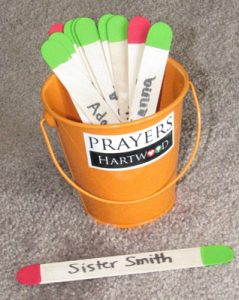
Use this tool to solve common problems you'll find in your gospel classroom. Select from the options below to find teaching techniques that will help you solve some of the most common problems in LDS gospel classrooms:
Have each student read a scripture on a gospel topic or a keyword written on a wordstrip and then place that wordstrip under the correct header.
EXAMPLE: I used this method to teach the plan of salvation. I divided the board into three sections: premortal, mortal, and postmortal. I also stuck Post-it notes with words like fall, creation, resurrection, birth, war in heaven, outer darkness, death, celestial glory, paradise, spirit prison, etc, underneath each of the chairs in the room. My Lesson opener was to introduce the material and then have the kids look under their seats to get their post it and stick it on the board in the correct section. Then as a group we would correct any mistakes, and we would go over each of the topics that needed explanation.
You know how this works: each student's name is written on a piece of paper. You draw a name out and that's the person who reads or prays next.
EXAMPLE: I use a bucket with craft sticks that have each student's name written on it. One end of the stick is red and the other is green. Students with red facing up, have been chosen. It's an easy way to remember who has already had a turn without having to keep track of a list. Students like that they can see they aren't being "picked on". I use it for randomly assigning prayers and keeping track of who has given prayers already. I have also used the bucket to draw names for scripture reading or sharing ideas as well.
It's easiest to use this method when a classroom's attendees don't change too much from week to week. But if you're using it in adult Sunday School or Elder's Quorum, you could have students write their names down on a list at the beginning of class, have a volunteer cut it apart, and then draw the names from the hat.

This is another form of student-directed randomized scripture reading. Students stand to read a verse and then call the name of someone else to stand and read the following verse. The kids are "popping" up to read.
This is also a good technique when you're doing Everybody Writes (each student writes a a brief response to something and then reports).
This is probably not a technique I'd use with adults, who can get very persnickety if called on out of the blue, UNLESS I had already established a good repoire with the class, had taught several lessons, and I knew that everyone in class could read.
Tell students you will give them sixty seconds to find out everything they can about a certain passage. If this is the first time your students have done an activity like this, you may want to give them a chance to tell you some techniques they might want to use: reading the chapter header, checking the footnotes, skimming, watching for the paragraph markers, etc.
Turn them loose. When the timer goes off, choose a student (randomly or otherwise) to tell what they learned about the chapter. Ask them to explain how they found out so much. Have another student or two do the same. At the end of the exercise, you may want to ask if anyone else used any techniques that weren't discussed, so that everyone can learn from other's ideas.
This is an easy way to start a lesson off so that everyone has the same background information before the class begins. It's also great for teaching students to use the scripture study aids.
WordStorm is kind of like brainstorming in that you take a topic word and write down the class' thoughts on the board. Easy Lesson opener.
EXAMPLE: I wrote the word "friend" on the board and asked my students to say words that describe a perfect friend. I noted their words on the board. When they slowed, I pointed out that Jesus Christ called some people his friends in the scriptures. Read D&C 83:77. It was his apostles... transition to the rest of your lesson
Teachers can randomly assign students to read randomly by calling them by name. The key is the order of the direction and the assignment. Here's how: "Turn in your Bible to Isaiah chapter 1. [pause] Everyone look at your scriptures. We'll be reading verses 1-15 aloud one at a time and discussing each individually. Verse one ...[pause]... John?"
The important thing is to direct everyone to the verse, pause, and then make the reading assignment. This direct and pause gets everyone to look at the material and then you make the assignment. Everyone is engaged with the material, and because they don't know who will be called on to read, they are paying attention. Now that the assignment is given, most students will follow along unconsciously because their attention has already been directed to the text.
I think this technique is best used when reading sections where you'll be discussing each verse as you move along. It's a little more serious and good for that kind of reading.
Some teachers are uncomfortable with cold-calling. Please know that cold-calling is not cruel or chastening or a negative teaching method. It's a way of helping each student engage and participate. There is an EXTENSIVE discussion of this technique on pages 111-125 of Teach Like a Champion by Doug Lemov.
In the gospel classroom, I don't use cold-calling for asking questions. I only use it for making assignments for reading or something else where it's easy for the student to participate. I also rarely use it to get someone's attention who is talking or distracted. Usually I touch that person on the shoulder and point at whomever is speaking. That's usually enough to get the person back on track without singling them out verbally.
Each student has a Styrofoam plate, a wet wipe, and a regular water cleanup (not permanent) marker. Ask students questions that can be answered in a few short phrases. They write their answers and flip over their plates. After a few moments, ask everybody to display their plates.
I have used this as a lesson review quiz and as a Lesson opener to help me determine what students already understand about a topic. When I know a little bit about what students already understand about a topic, I know where to begin our discussion.
You can also use this to have students search for answers in the scriptures, and then write them down.
Sometimes you can get real dry erase slates at the dollar store inexpensively. Styrofoam plates are inexpensive, readily available, and can be reused several times before tossing.
Give each student a pencil and piece of paper. Tell your students that they will be cartoonists and should draw a cartoon of the story you are about to read aloud. Stick figures are perfectly okay -- this is not about drawing skill, but it's about picking out the most important details they hear from the story. Let them know they will get a chance at the end of the reading to finish up their work. At the end of your reading, set a timer for 45-60 seconds to give students a little time to fill in any details they wanted to add.
This helps keep students focused and interested during a moderately long reading. It is also a good opportunity for students to show each other their work and discuss their drawings -- it's your secret way of reinforcing the teaching through repetition, AND they will unconsciously share what they learned from the story. This works well with stories that have lots of concrete details and/or action.
This would be a fun activity to do while discussing the Creation or an event in Church history.
You could do this in a class of adults, too -- many adults can still draw, or at least laugh at their lack of skill!
Give students a few minutes to review a passage that is fairly familiar to them. Have them write down something that was "new" at this reading. They may have remembered a detail they forgot or noticed something new. They may have a new understanding of what certain words or phrases mean. The verses may have triggered a new question. If they can't find something new, I let them share something that was interesting or important to them.
I always do this activity as a timed activity. I set the timer for a few minutes (usually two or three) and let students hunt for something new. They write down their item so I can tell when everyone is finished.
You may want to point out that each time we read scriptures, we are coming from a different stage in our lives which can make even familiar stories "new" to us again.
This is a good way to begin a gospel discussion on a longer passage of scripture. The discussion will trigger lots of questions and answers.
My students love group drawing. It's good for covering material that is easy to imagine visually. I have also used it to cover distressing topics -- like the events preceding the second coming -- because these events seem less frightening when sketched for some reason.
I have done group drawing a couple of ways. One is to divide the class into small groups and have the whole group drawing at once. The other is to have students read a verse or two and then come up one at a time to draw their picture while the next person reads their verse aloud. It will take you a little time during your lesson preparation to determine what to draw and how to split up your groups.
I used the group drawing when we covered Pharaoh's dreams of the fat/lean corn, fat/lean kine, and the baker's dream. Three groups all took one of the dreams and drew what they could remember on the board.
I used the group drawing one person at a time when we covered Joel 2 and D&C 45. Students read a passage of scripture aloud and then went to the board to draw a picture of that sign of the second coming. They could draw for as long as the next person was reading or discussing their passage.
Both activities turned out great -- the group drawing was a fun way to have students retell stories they knew, and the individual drawings of the scary topic helped students learn signs but kept everyone from being afraid. These pictures always end up on Facebook, and the students love to explain what they're about to their friends.